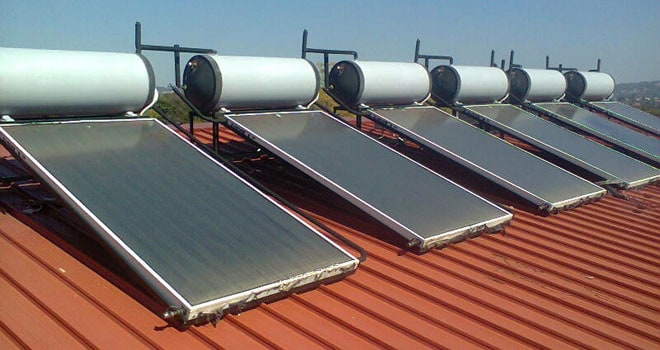In this post, I am going to give you accurate Solar Geyser prices in South Africa and other necessary information worth knowing about Solar geysers as a consumer.
Let’s first start by looking at what a solar geyser is and the types of solar geysers available on the market before we focus on the reason why you clicked on this post.
What Is A Solar Geyser?
A solar geyser is a device that heats water by capturing sunlight. It might be a cost-effective solution to provide hot water for your home (for shower and bath).
A solar geyser saves you money on energy because solar power is free, unlike natural gas or fuel oil. Furthermore, it provides a means to produce hot water for sanitary purposes all year without releasing CO2.
Types Of Solar Geyser
To find the right type of Solar Geyser for you it’s best to understand the different options, here are the main types available, how they work and their Pros and Cons.
- Flat Plate
- Evacuated Tube
- Retrofit
- Thermosiphon
- Direct Thermosiphon
- Indirect Thermosiphon
- Closed Coupled
- Low Pressure
Flat Plate Solar Geyser
For our South African climate, a Flat Plate Solar Geyser is ideal.
How does it work?
To heat the water, it needs direct sunlight, preferably from the north, and it should be free of any cast shadows from trees or buildings.
Evacuated Tube Solar Collector
The most efficient collectors on the market are evacuated tube collectors.
How does it work?
It was originally created for European settings when sunshine is sparse and temperatures are significantly lower. UV rays, rather than direct sunlight, are used in this collector system.
Pumped Solar Geyser System
When the storage tank or electric geyser is below the position of the collector, a pumped system, also known as a “Retrofit,” is used.
How does it work?
The water from the geyser must be re-heated and forced up into the collector before being pumped back down into the geyser.
Although there are more moving parts, which means this option requires more maintenance, it is also a more cost-effective option and is less of an eyesore because the tank is not visible from the roof.
Thermosiphon Solar Geysers
These Solar Geyser systems are the most frequent and reliable because there are few parts and the main process is natural.
How does it work?
The solar water collector receives cold water, which is then heated by the sun. Because hot water rises and cold water sinks, all of the hot water is automatically forced to the top of the collector and into the geyser above it.
Direct Thermosiphon Solar Geysers
A Direct Thermosiphon Solar Geyser uses a typical thermosiphon geyser that does not require protection in cold weather.
What is the mechanism behind it?
Although it is still intended to endure exterior weathering, it does not provide any additional insulation for water storage.
Indirect Thermosiphon Solar Geysers
An Indirect Thermosiphon Solar Geyser is a type of solar geyser that is developed for use in severely cold climates.
How does it work?
Because the geyser is on the roof, it is exposed to the open air, which causes ice to form as the temperature drops.
The indirect geyser features a jacketed layer surrounding the cylinder that is filled with glycol, an insulating liquid, to keep the water in the tank from freezing or cooling too quickly.
Closed Coupled Solar Geysers
Solar geysers with a closed coupling are one-piece systems.
How does it work?
The tubes are inserted directly into the tank and are connected with sleeves. These are direct thermosiphon systems, therefore they’re only good for places that don’t get too cold in the winter.
Low-Pressure Solar Geysers
Low-pressure Solar Geysers are closed coupled systems that use gravity to transmit heated water.
These systems are ideal for use on farms or in places where the temperature rarely falls below 15 degrees. Because the hot water is gravity supplied, the cold water mixing renders it too chilly to use, resulting in only a very light shower.
Prices of solar geysers in South Africa
Solar geysers have undoubtedly come down in price, and because of new construction laws, they are now obliged to be placed in every new house built.
The low cost not only makes it appealing in general, but it also saves a lot of money; a 100L Low-pressure Solar Geyser costs as little as R3,323 and a top-of-the-line 200L High-pressure Solar Geyser costs as much as R19,441.
Kwikot solar geyser prices
After scouring the internet we found out that the average price of a 100L Kwikot solar geyser is R 3,399 including VAT.
Solar Geyser Prices At Builders Warehouse
Apollo Solar Technology APIHP-30 Integrated High-Pressure Solar Geyser (300L) – R24,950.
Apollo Solar Technology APSP-20-HT Retrofit High-Pressure Solar System with Geyser (200L) – R16,990.
Builders 100 Litre Solar Geyser – R13,828
Apollo Solar Technology ASLP-12 Integrated Low-Pressure Solar Geyser (100L) – R7,620.
Solar geyser prices at Game
Low-pressure – From R 4,000 to R 12,000.
Closed Coupled High-pressure – From R 12,000 to R 25,000.
Direct thermosiphon systems – From R 12,000 to R 25,000.
Indirect thermosiphon – From R 12,000 to R 25,000
